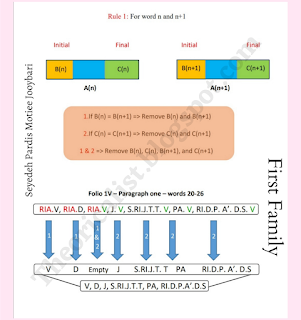An Introduction to Voynich Manuscript Decipherment: How to use the Alphabets
At this moment, that corona has influenced our environment, I prefer to share all I can. I realized that in this path of translating the voynich manuscript, trying to convince people is not my duty. The world of alive creatures, the magic of life is what I will enjoy, whereas deciphering this book is like solving a rubik, a puzzle, and it's more than my capacity when I see people in the wrong path. I am sure that everyone would be able to read voynich manuscript with patience and peaceful mind. The topic of this post is about using the alphabets. I have improved the set, and now it's even more powerful.
 |
| Voynich Manuscript Alphabets |
We have voynich letters in row (a), these are what we see in the written form of manuscript. At the row (b) the letters for searching in dictionaries are given. These are based on pronunciation and observed phonological change. And finally, row (c) has letters for transcription. When we omit the repetitions, we often need to transcribe the writings.
Some Voynich letters are showing similar structures to Farsi and Arabic. For the transcribed M, we have two forms, first when it is inside a word and second when it is the final letter. This shows similarity to م in Farsi and Arabic scripts. The letter V works same as و in these languages. And three T (T, T', T") may indicate different T sound letters again in these scripts. However, for T it seems a way to make the reading more complicated. When some pages do not have one T, the other T s(T' or T") are present there.
PA, GA, RIA and RI, consist of two letters, and therefore I call them compound letters. (PA=P + A) There are other shapes in manuscript, like A +P =AP. But is this different from PA? Probably yes.
The main alphabets seem a mixture of letters from different, related scripts "Brahmic descendent scripts". With almost same pronunciation and shape (See here).
Kharosthi the ancient Indian script, originated under the influence of the Semitic script (Aramaic) used by the Persians, the script arrived to other areas with help of Silk road and even had been found in Greek coins [1] Does this show any clue? Is this an ancient, extinct script?! In my view, any explorer, historian or linguist could create the alphabets.
The second row shows a list of letters for each voynich letter. The S sound can be represented with three different shapes in Farsi so, when we want to find the word in today's dictionary, we would need to change the script based on phonetics. The other important matter, is phonological changes, for example in old times H could be pronounced Kh like هور "hur" and خور "khur" meaning "Sun", knowing these substitutes will help in translation. However the letter H is always one shape, and showing with different substitutes is not recommended for transcribing.
For transcription, we need one substitute for one voynich letter. And these substitutes should be easy to use and transform to Farsi script (after omissions). As the writings are left to right, English is best for transcription, and following Fingilish (Farsi +English), one can simply change it to Farsi after omitting the repetitions.
1) Transcribe 2) Apply the rules 3) Change the script 4) Search in dictionaries 5) Translate
Now, you may question, can this alphabet produce meanings without omission rules?
See words 32 to 35 of paragraph one, page one. This is a good example, in the first page: PA.A.A.R, S.A.M, D.RI.A.M, D.R, D.RI.A.M. Here a Persian speaker will immediately notice the meanings. Daryaye Pars/Pars Darya(دریای پارس/پارس دریا) = Persian Sea. And here Parsam Daryam(پارسم دریام) . And Dar Daryam (در دریام) = I am in sea.
S. P. Motiee Jooybari
References
1.Violatti, C. (2017, May 25). Kharosthi Script. World History Encyclopedia. https://www.worldhistory.org/Kharosthi_Script/


Comments
Post a Comment